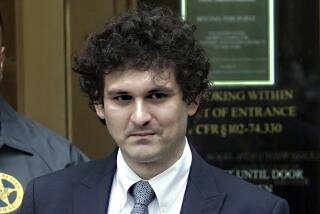Knight Capital’s big glitch could bring better regulations, CEO says
- Share via
New regulations following Knight Capital Group’s nearly fatal computer-trading glitch could make the financial system stronger, the brokerage’s chief executive said.
“We paid a big price for a better outcome,” Tom Joyce, who is also Knight’s chairman, told a Barclays financial services conference in New York.
Knight’s Aug. 1 trading debacle showed how operational risk, not “regulatory risk,” is the biggest threat facing firms as stock trading has become faster and more computerized, Joyce said.
Knight will soon announce the appointment of a new risk officer, he added.
On Aug. 1, newly installed trading software at Knight accidentally sent a slew of errant trades into the stock market, costing the firm $440 million. Knight, a New Jersey-based brokerage and a major behind-the-scenes force on Wall Street, needed rescue financing to stave off collapse.
At the Tuesday morning conference, Joyce blamed the faulty trading on software that was somehow activated when the new trading program went live.
“In effect, we kicked the beehive,” Joyce said.
Knight was “completely embarrassed” to have a technology debacle after the Nasdaq Stock Market had its own glitches that marred Facebook’s initial public offering in May, Joyce said.
Joyce conceded the twin high-profile debacles likely didn’t inspire much faith in individual investors.
“We haven’t exactly given the retail investor a lot of reason to have confidence,” he said.
Knight’s trading debacle has prompted a review by the U.S. Securities and Exchange Commission.
Joyce expects regulators to focus on rules that would cut off trading in stocks amid unusually heavy trading, known as volume circuit breakers.
Joyce also said he expected regulators to review rules governing when Wall Street firms can undo erroneous trades. Many of Knight’s bad trades did not qualify as “clearly erroneous” under securities regulations and weren’t canceled.
“There’s no reason to put a firm at risk because some knucklehead or series of knuckleheads at the firm made a big mistake,” Joyce said. “If it was an error, you should be able to fix an error.”
New regulations could also require a “kill switch” that could abort runaway computer trading algorithms before they do too much damage.
But Joyce said a kill switch should not shut an entire firm down if there’s a problem in only one trading area.
“There are things you need to make sure you take into consideration before you just hit the big red button,” he said.
ALSO:
Feds say AIG stock sale locks in minimum $12.4-billion profit
Consumer debt falls unexpectedly as credit cards stay in wallets
As in U.S., conservatives in Germany question central bank action
More to Read
Inside the business of entertainment
The Wide Shot brings you news, analysis and insights on everything from streaming wars to production — and what it all means for the future.
You may occasionally receive promotional content from the Los Angeles Times.










